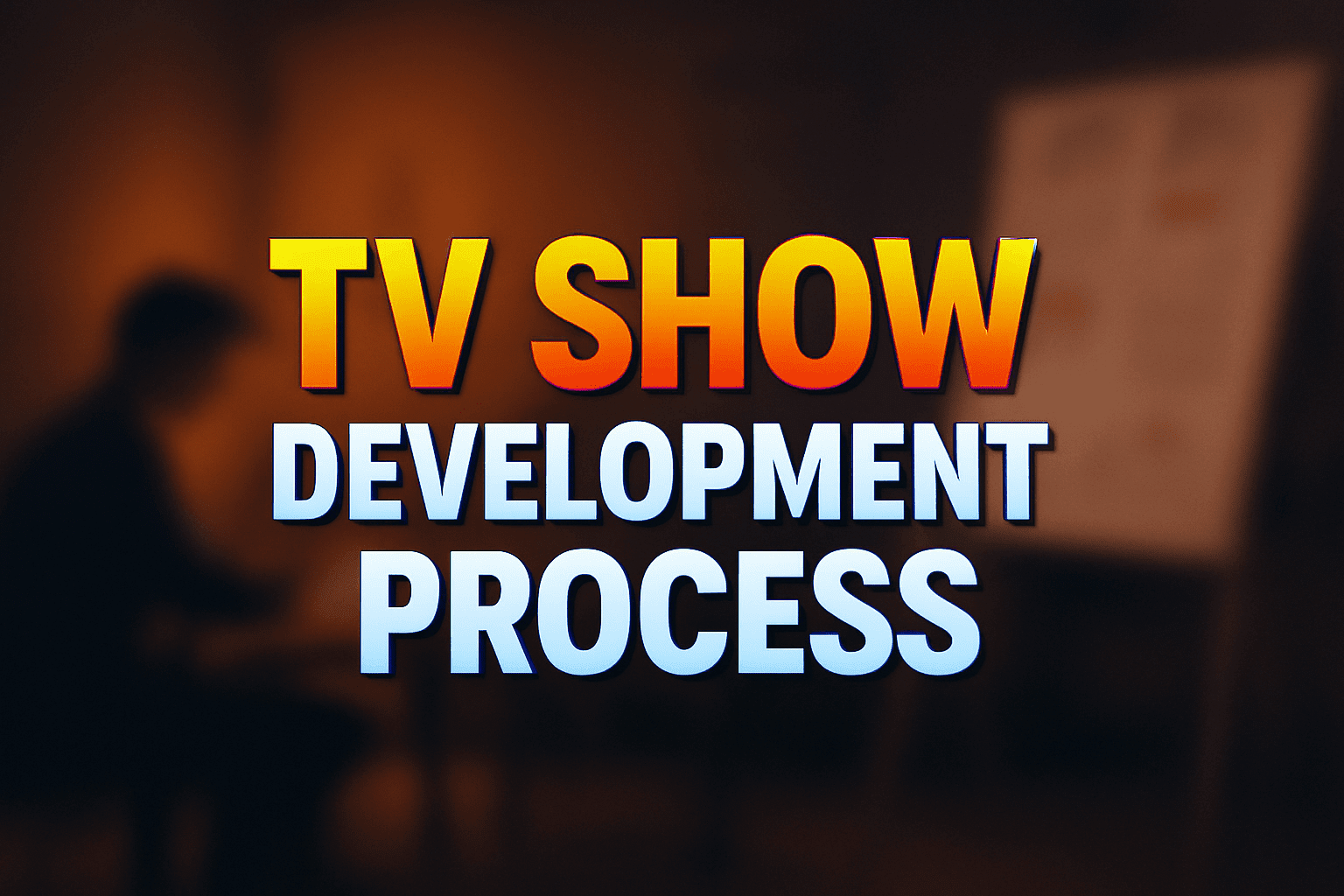The TV Show Development Process: A 2025 Insider’s Guide

Introduction
The journey of a hit television series from a simple idea to a global broadcast is one of the most complex creative and commercial undertakings in the modern media landscape.
For every acclaimed series that captures the cultural zeitgeist, hundreds of promising concepts fail to navigate the labyrinthine TV show development process.
This initial stage is a high-stakes filter designed to identify, refine, and validate ideas that have the potential to attract massive audiences and generate significant returns.
For executives, producers, and creators, mastering this phase is not just about creativity; it’s about strategic precision, market awareness, and the ability to build a compelling business case for a project long before the cameras roll.
This guide breaks down the five critical stages of the development process, providing the clarity needed to transform a promising concept into a greenlit series.
Table of content
Key Takeaways
| Core Challenge | The TV show development process is opaque and fiercely competitive, making it difficult to track emerging trends and identify high-potential concepts early. |
| Strategic Solution | Utilize a global project tracking system to monitor competitor development slates and identify trending genres, IP, and creative talent in real-time. |
| Vitrina’s Role | Vitrina’s platform offers comprehensive tracking of film and TV projects in development, providing the critical intelligence needed to make smarter greenlighting decisions. |
Understanding the Development Funnel in the TV Show Development Process
The television development process functions as a rigorous and highly selective funnel. At the top of this funnel, thousands of ideas are generated and considered by production companies, studios, and networks each year.
At the bottom, only a small fraction—perhaps less than 1%—emerge as fully commissioned series. A report from Variety highlights the intensifying competition, noting a significant decline in new series orders as streamers and networks become more risk-averse in a post-“Peak TV” market. This makes the early stages of development more critical than ever.
Each stage of the funnel is a decision point where a project must prove its creative merit and commercial viability to advance. A concept might be compelling, but if it cannot attract the right talent, it may stall.
A brilliant pilot script might be written, but if it doesn’t align with a network’s current programming strategy, it won’t receive a pilot order. For executives, the challenge is to manage this process efficiently, killing projects that lack potential while championing those with the highest probability of success.
This requires not just creative instinct, but a deep, data-informed understanding of the market, competitor activities, and audience trends. It is a foundational part of the broader TV series lifecycle, setting the stage for everything that follows.
Stage 1: Concept and Ideation
Every television series begins with a single element: the core concept. This is the foundational “what if?” that defines the show’s premise, world, and characters. Ideas can be sourced from anywhere, but they generally fall into a few key categories:
- Original Ideas: Concepts born directly from the mind of a writer or creator. These are often the most unique but can also be the most challenging to sell without a pre-existing brand.
- IP Adaptation: Sourcing ideas from existing intellectual property is an increasingly dominant strategy. This includes adapting books, graphic novels, podcasts, video games, or even news articles. This approach comes with a built-in audience and a proven narrative, which significantly de-risks the project for buyers.
- Talent-Driven Projects: Sometimes, development is initiated around a specific actor, director, or showrunner who has a passion project they wish to develop.
During this stage, the primary goal is to distill the idea into a clear and compelling logline—a one- or two-sentence summary that encapsulates the essence of the show. Executives are looking for concepts that are not only original but also have “legs”—the potential to sustain a narrative over multiple seasons.
Stage 2: Packaging the Project
An idea alone is not enough to sell a show. The next critical step in the TV show development process is packaging, where the core concept is built out with essential creative materials and attachments. The goal is to create a comprehensive package that demonstrates the project’s viability and vision to potential buyers.
The key document at this stage is the series bible. This is a detailed blueprint for the show, often running 20-50 pages, that typically includes:
- Detailed Character Breakdowns: In-depth descriptions of the main characters, their backstories, motivations, and arcs.
- Season 1 Outline: A summary of the major plot points and character journeys for the first season.
- Multi-Season Plan: A brief overview of how the story could evolve in subsequent seasons, proving the show’s longevity.
- Tone and World Description: A guide to the show’s visual style, atmosphere, and the rules of its world.
Alongside the bible, the package often includes a pilot script. This is the first episode, and it must perfectly establish the show’s tone, characters, and central conflict. In many cases, key talent is “attached” to the project at this stage. Attaching a well-known showrunner, director, or lead actor can dramatically increase a project’s perceived value and chances of being picked up.
Stage 3: The Pitch
With a polished package in hand, the producers and creative team are ready to pitch the show to potential buyers—the studios, broadcast networks, and streaming services. The pitch is a highly structured presentation, typically lasting 20-30 minutes, where the team passionately sells their vision for the series.
The pitch meeting is a performance with a clear objective: to convince executives that this show is a perfect fit for their platform and will resonate with their audience.
The team will walk through the core concept, the characters, the season-one arc, and the long-term potential of the series. They must also be prepared to answer tough questions about budget, target demographics, and how their show stands out in a crowded marketplace.
Success in this stage depends on targeting the right buyers. A gritty, serialized crime drama is unlikely to find a home at a network known for family-friendly sitcoms.
Therefore, a crucial part of the strategy involves researching the current programming needs and brand identity of each potential network or streamer. For more insight on finding the right partners, see our guide to finding co-production partners.
Stage 4: Scripting and Pilot Production
If the pitch is successful, a network or studio will “buy” the project. This usually takes the form of a script deal, which can have several variations:
- Script Order: The network pays for a pilot script to be written.
- Script-to-Series Commitment: A stronger vote of confidence where the network commits to ordering the show to series if they approve of the script, bypassing a traditional pilot.
- Pilot Order: The most common path, where the network greenlights the production of a single pilot episode.
The pilot is a multi-million dollar proof-of-concept. Its sole purpose is to demonstrate that the ideas on the page can be translated into a compelling and well-executed episode of television. The pilot production process is a microcosm of a full season’s production, involving casting, location scouting, shooting, and post-production. Once complete, the pilot is screened for network executives and often tested with focus groups to gauge audience reactions.
Stage 5: The Greenlight Decision
This is the final and most nerve-wracking stage of the TV show development process. After reviewing the finished pilot, analyzing audience test data, and assessing how the project fits into their overall programming slate, the network executives will make the ultimate decision: to greenlight the show for a full season or to “pass” on the project.
The greenlight is an order for a full season, which can range from 6-13 episodes for streaming and cable or up to 22 episodes for traditional broadcast networks. If a show is greenlit, the writer’s room is assembled, and the project officially moves out of development and into pre-production for the full season. If the network passes, the pilot is shelved, and the project is considered “dead” at that platform.
In some cases, the studio that produced the pilot may try to shop it to other interested buyers, but this is a difficult path. The greenlight decision marks the end of the development journey and the beginning of the show’s life as an active production.
Navigating the Modern TV Show Development Process with Data
In an industry defined by intense competition and shifting audience tastes, relying on instinct alone is no longer a viable strategy. Winning the development game requires a rigorous, data-informed approach. By systematically tracking which projects are being developed across the industry, executives can gain invaluable intelligence. This allows them to:
- Identify Market Gaps: See which genres or types of IP are underserved.
- Anticipate Trends: Spot emerging trends, such as the rise of sports documentaries or specific sub-genres, before they become saturated.
- Benchmark Against Competitors: Understand the strategic direction of rival studios and streamers.
- Discover Talent: Identify writers, directors, and production companies associated with high-potential projects.
Vitrina’s Global Film+TV Projects Tracker is designed for this exact purpose. It provides a real-time, comprehensive view of the entire development landscape, empowering decision-makers to move beyond guesswork and make strategic choices backed by global market data. By using this intelligence, companies can increase the efficiency of their development pipeline and improve their odds of greenlighting the next hit series.
Conclusion: From Idea to Greenlight
The TV show development process is a formidable journey, a multi-stage gauntlet designed to separate commercially viable, creatively excellent concepts from the noise.
It begins with a spark of an idea and proceeds through a structured process of packaging, pitching, and pilot production, culminating in the critical greenlight decision. Each step requires a unique blend of creativity, strategic planning, and business acumen.
In the current content environment, success in this process increasingly depends on supplementing creative instinct with hard data and market intelligence, ensuring that every decision is made with a clear and comprehensive view of the entire global development landscape.
Frequently Asked Questions
The development process for a TV show can vary significantly. From initial concept to a greenlight decision, it can take anywhere from six months for a project on a fast track to several years for one that requires extensive script revisions, talent negotiations, and packaging.
A series bible is a comprehensive document created during the TV show development process that serves as a blueprint for the series. It typically includes detailed character descriptions, a summary of the first season’s plot arc, and an overview of potential future seasons to demonstrate the show’s long-term viability.
A pilot is a standalone proof-of-concept episode produced to convince a network to order a full season of a show. The series premiere is the first episode that airs to the public once the show has been greenlit. In many cases, the pilot episode is reworked or even entirely re-shot before it becomes the series premiere.
Writers typically do not pitch ideas directly to networks. The standard path is to first secure representation with a literary agent or manager. The agent then uses their industry connections to get the writer’s script or pitch in front of producers and development executives at production companies, who may then partner with the writer to take the project to the networks.

























